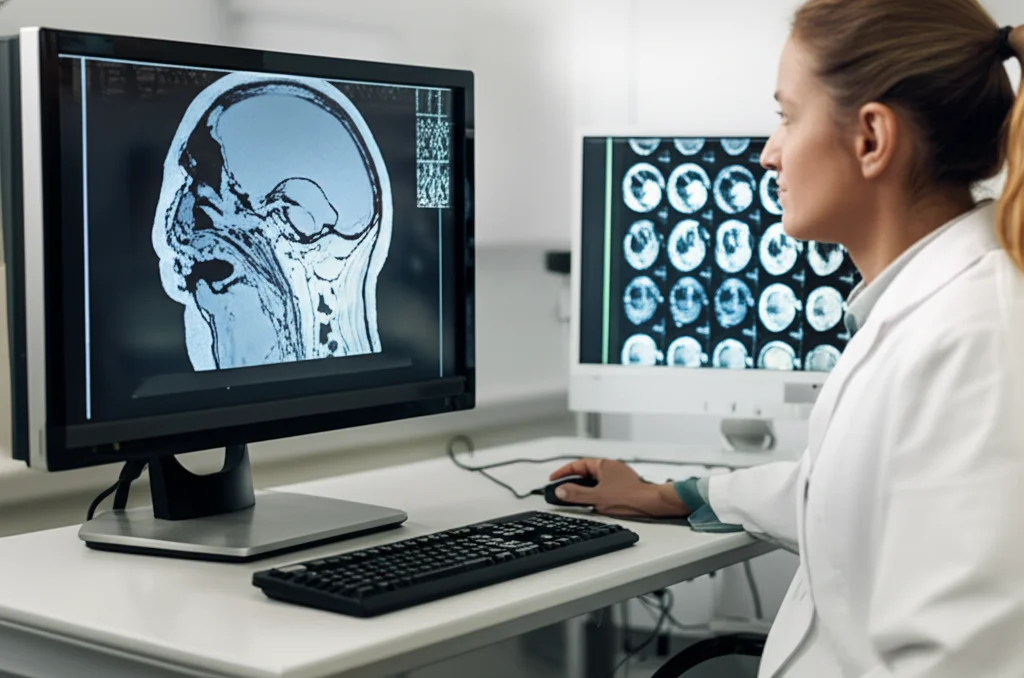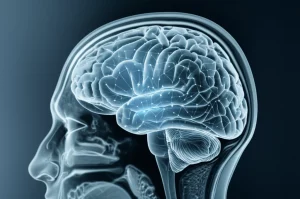MRI’s Secret Weapon: Telling Benign from Metastatic Lymph Nodes
Hey there! Let’s dive into something pretty cool and super important in the world of medical imaging. We’re talking about those little bean-shaped structures called lymph nodes, specifically the ones tucked away in the back of your throat area – the retropharyngeal lymph nodes, or RLNs for short.
Now, these RLNs are a big deal, especially if someone is dealing with Nasopharyngeal Carcinoma (NPC), a type of head and neck cancer. They’re often the first place this cancer spreads. Knowing whether an enlarged RLN is just reacting to something harmless (benign) or if it’s carrying cancer cells (metastatic) is absolutely critical for deciding the best treatment plan.
The Challenge: A Tricky Distinction
Here’s the rub: telling the difference between a benign, reactive RLN and a metastatic one isn’t always straightforward. Standard MRI scans look at things like size and appearance, but benign nodes can sometimes get big too, especially in people with certain viral infections like Epstein–Barr virus (which is linked to NPC). This overlap makes it tough to rely just on size. It’s like trying to pick out a specific type of apple from a barrel when they all look kind of similar on the outside.
Conventional diffusion-weighted imaging (DWI), another MRI technique that looks at how water molecules move in tissues, has been used, but its basic version (giving us the Apparent Diffusion Coefficient, or ADC) hasn’t been a superstar at this job either. Why? Because conventional DWI assumes water moves in a simple, uniform way (Gaussian diffusion), which isn’t really true in complex, heterogeneous tissues like lymph nodes, especially cancerous ones.
Introducing the Advanced Models
This is where the really interesting stuff comes in. Scientists have developed more sophisticated ways to analyze DWI data that *don’t* make that simple assumption. These are called non-Gaussian diffusion models, and they can give us a richer picture of the tissue’s micro-environment – things like cell density, cell membrane integrity, and how heterogeneous (or varied) the tissue is at a microscopic level.
This particular study I’ve been looking at decided to put four different MRI diffusion approaches head-to-head:
- Conventional DWI (the old faithful, giving us ADC)
- The Stretched-Exponential Model (SEM)
- The Fractional-Order Calculus (FROC) model
- The Continuous-Time Random Walk (CTRW) model
They wanted to see if the parameters derived from these newer models, either alone or combined with traditional morphological features (like size), could do a better job of separating the good nodes from the bad ones.
Putting the Models to the Test
So, how did they do it? They gathered data from 59 patients who had 68 RLNs that needed checking out – some were confirmed benign (often through follow-up showing they didn’t grow or disappear after treatment), and some were confirmed metastatic (linked to NPC that resolved after treatment). They used a high-tech MRI scanner and a special DWI sequence that collects data at 12 different ‘b-values’ (those are the settings that influence how much diffusion weighting is applied). More b-values mean more data points to feed into those complex non-Gaussian models.
After scanning, they used special software to process the raw data and calculate nine different parameters – one from conventional DWI (ADC), two from SEM (DDCSEM, αSEM), three from FROC (DFROC, βFROC, μFROC), and three from CTRW (DCTRW, αCTRW, βCTRW). They also measured the minimal axial diameter (MiAD) and noted other features like signal homogeneity and borders.
Two experienced radiologists independently reviewed the images and measurements, and a third expert resolved any disagreements. This kind of careful, blinded assessment is key to getting reliable results.
What the Numbers Revealed
When they crunched all the numbers, the results were pretty telling.
* Diffusion Parameters: Most of the diffusion parameters were significantly different between the benign and metastatic RLNs (except for one from the CTRW model, αCTRW). Generally, the benign nodes showed values suggesting more ‘free’ or less restricted water movement (higher ADC, DDCSEM, DFROC, DCTRW), while the metastatic nodes had values indicating more restriction and heterogeneity (higher αSEM, βFROC, μFROC, βCTRW). This makes sense – cancer cells are often densely packed and create a more complex, tortuous path for water to diffuse through.
* Morphological Features: Among the traditional features, only the minimal axial diameter (MiAD) was significantly different – metastatic nodes tended to be larger, which isn’t surprising, but as mentioned, there’s overlap. Other features like signal homogeneity or borders weren’t significantly different in this study population.
* Diagnostic Performance: This is where the rubber meets the road. They used a statistical method called ROC analysis to see how well each parameter could differentiate the two groups.
* The conventional ADC didn’t do great, with an Area Under the Curve (AUC) of only 0.671. An AUC of 1 is perfect, 0.5 is random chance. So, 0.671 isn’t exactly knocking it out of the park.
* The MiAD was a bit better at 0.727, but still not fantastic, confirming that size alone isn’t the answer.
* Many of the non-Gaussian parameters performed better than both ADC and MiAD.
* But there was a clear winner among the *single* diffusion parameters: βCTRW from the CTRW model. It boasted an impressive AUC of 0.913! That’s a big jump in diagnostic power compared to the traditional methods.

* The Power of Combination: The study then looked at combining the best single diffusion parameter (βCTRW) with the best morphological feature (MiAD). And guess what? This combination was the most powerful differentiator of all, achieving an AUC of 0.948! This combined model significantly outperformed most individual parameters, including ADC and MiAD alone.
Why This Matters
So, what’s the takeaway from all these parameters and AUCs? It seems that these advanced non-Gaussian diffusion models, particularly the CTRW model and its β parameter, are giving us a much more sensitive look at the internal structure and complexity of these lymph nodes than conventional methods. They can pick up on subtle differences in how water moves that are linked to whether the node is just inflamed or if it’s invaded by cancer cells.
Finding that βCTRW is such a strong indicator is exciting because it’s a noninvasive measurement. For patients with NPC, where surgically removing or even biopsying these deep RLNs is difficult and often not part of the primary treatment, having a reliable imaging biomarker is incredibly valuable.
This improved diagnostic accuracy means doctors can be more confident in determining the stage of the cancer (N staging) and, crucially, in planning radiotherapy. Knowing exactly which nodes are metastatic allows for more precise targeting of treatment, potentially sparing healthy tissues and reducing side effects, while ensuring the cancerous nodes receive the necessary dose.
Looking Ahead: Limitations and Future Directions
Now, no study is perfect, and this one has its limitations, which the researchers openly discuss. It was conducted at a single center with a specific patient group, so the findings need to be confirmed in larger, multi-center studies. Also, because biopsies of RLNs are tricky, the diagnosis of ‘benign’ or ‘metastatic’ wasn’t always based on tissue pathology from *that specific node* but rather on clinical follow-up and the patient’s overall condition and response to treatment.
They also used 2D regions of interest (ROIs) to measure the parameters, drawing a circle on one slice of the node. Using 3D volumes of interest (VOIs) might capture the node’s heterogeneity even better, though that’s more work (maybe AI can help here in the future!).
Finally, while we know *that* these diffusion parameters are different, we still need to fully understand the *exact* biological reasons *why* at a cellular and microstructural level. Future research could involve correlating these imaging findings directly with tissue samples (if possible) to really map the link between diffusion patterns and things like cell density, blood vessels, and the surrounding matrix.

The Bottom Line
Despite the limitations, this study provides compelling evidence that going beyond conventional MRI and morphology is the way forward for evaluating RLNs. The non-Gaussian diffusion models, especially CTRW, offer superior diagnostic power. And when you combine the star parameter, βCTRW, with the minimal axial diameter, you get a really robust tool for differentiating benign from metastatic RLNs.
This isn’t just academic; it has real potential to improve how we stage and treat NPC, leading to more personalized and effective care. It’s exciting to see how these advanced imaging techniques are giving us a clearer window into the complexities of cancer spread.
Source: Springer






